Sponsored by PerkinElmerReviewed by Olivia FrostMay 3 2023
Per- and polyfluoroalkyl substances (PFAS) have garnered considerable attention as a developing safety and environmental threat in the United States. PFAS have been widely used in industry since the 1940s because of their thermal and chemical stability, as well as their high resistance to degradation.
There are various sources of PFAS, such as chemical manufacturers, where PFAS are released during the thermal treatment of waste and products of incomplete combustion. PFAS are also found in many products, such as cosmetics, fire extinguishing foams, cleaning supplies, food packaging, and non-stick cookware.
Bioaccumulation at landfills and production sites allows PFAS compounds to be absorbed into the ground and surface water. Water contaminated with PFAS water is subsequently used for agricultural applications and human consumption without the proper measures to eliminate the contaminated particles.
The Environmental Protection Agency (EPA) has established a regulatory strategy to address the contamination of drinking water with PFAS. Regulations, including the Fifth Unregulated Contaminate Monitoring Rule (UCMR 5), are particularly important at present due to the required analysis of PFAS by public water systems.
More than 10,000 water systems are in need of analysis, and this sampling period is predicted to conclude in 2025 when collected sampling data is to be analyzed for the 2026 review.
There are numerous analytical challenges when evaluating PFAS, such as larger sample sizes, ultra-sensitivity capacities for analytes, laborious sample preparation, and the elimination of contamination sources of PFAS within the analytical equipment and external sources.
To assess the low levels of PFAS, a highly sensitive mass spectrometer or a sample preparation method that involves a concentration step is required. The use of solid phase extraction (SPE) together with LC/MS/MS is a highly popular method for PFAS analysis in aqueous samples, with implementation in EPA Method 533 and 537.1.
Applying Methods 533 and 537.1, PerkinElmer has successfully created and validated an LC/MS/MS method that removes contamination risk, increases throughput, and decreases runtimes by almost 70% for PFAS analysis in surface and drinking water samples by using an LX-50 UHPLC system to a QSight 420 triple quadrupole mass spectrometer.
This article presents key insights into regulatory requirements and the most recent advances in PFAS analysis.
EPA’s PFAS Action Plan
EPA’s PFAS Action Plan presents a summary of the steps that the agency is taking to tackle PFAS and to protect public health. The PFAS Action Plan entails the supply of both short and long-term solutions in response to the public input received by the agency since the PFAS National Leadership Summit.
The main actions of this plan are presented in Figure 1.1
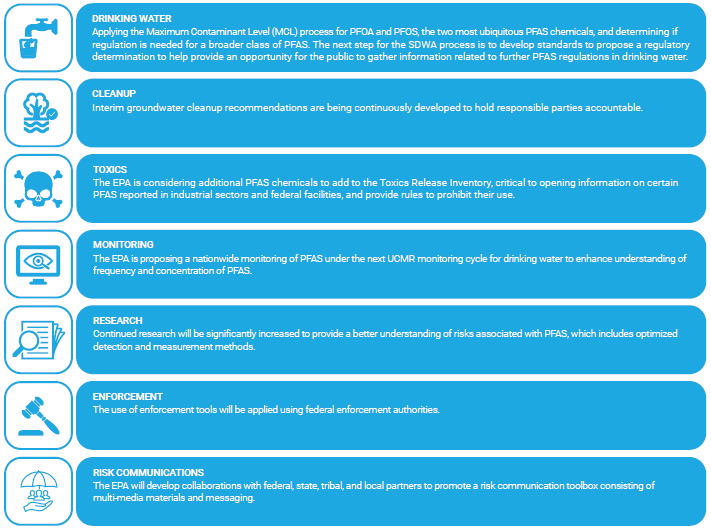
Figure 1. Image Credit: PerkinElmer
The EPA’s Approach to PFAS
The integrated approach to PFAS by EPA includes three central directives that center on improving contamination by PFAS.2
1. Research
Investment in research and development is being made by the EPA to improve understanding of PFAS exposure and toxicity.
This research includes studying the lifecycle of PFAS, ensuring science-based decision-making to classify PFAS and methods, recognizing sources of contamination and exposure pathways, and understanding the effect of PFAS pollution on communities.
2. Restrict
The EPA will focus on preventing PFAS from entering the environment and using statutory authorities to hold polluters accountable. Additionally, they will launch voluntary programs for the reduction of PFAS emissions and to avoid or minimize the impact of PFAS emissions on all communities.
3. Remediate
To enable fast and all-encompassing remediation of PFAS contamination, the EPA will utilize the power of statutory authorities to maximize the funding and performance of responsible parties, speed up the implementation of treatment and disposal of PFAS, and prioritize protecting disadvantaged communities via fair access to PFAS solutions.
The Safe Drinking Water Act and Regulatory Process
The Safe Drinking Water Act (SDWA) uses both risk and data-driven processes to evaluate water contaminants. The EPA demands water systems to carry out sampling every five years for unregulated contaminates as a result of SDWA.
The EPA published the Fifth Unregulated Contaminant Monitoring Rule (UCMR 5) in December 2021. This proposed critical new data to better the EPA’s understanding of the frequency of 29 PFAS compounds discovered in the nation’s drinking water and, in particular, at which levels.
UCMR 5 is expected to increase the amount of participating drinking water systems, producing data that will improve their ability to perform both local and state assessments of contamination.3
The Safe Drinking Water Act regulatory process commences with the draft of a contaminant candidate list (CCL). Once this list is finalized, it is utilized to create a UCMR, with monitored results.
Together, the CCL and UCMR are utilized to determine preliminary regulatory determinations and subsequent final regulatory determinations. At this point, no action is required if the decision is to not regulate.
However, if a decision is made to regulate, the final regulatory determinations will produce a proposed rule within 24 months. Following this, a final rule, referred to as the National Primary Drinking Water Regulation (NPDWR), will be introduced following an additional 18 months.
Ending this regulatory process is a six-year review of existing NPDWRs. A summary of the Safe Water Act Regulatory Process is displayed in Figure 2.3
Regulatory Background and UCMR 5 Program
SDWA was developed by the EPA in 1974 for the protection of the quality of drinking water. In 1986, amendments required 25 new MCLs every three years, limiting lead usage, opening the state revolving loan fund, and acting as a pre-cursor to the CCL.
Further amendments made in 1996 integrated risk-based standards, establishing UCMR and CCL. Significant infrastructure funding was also established with annual CWSs reporting.
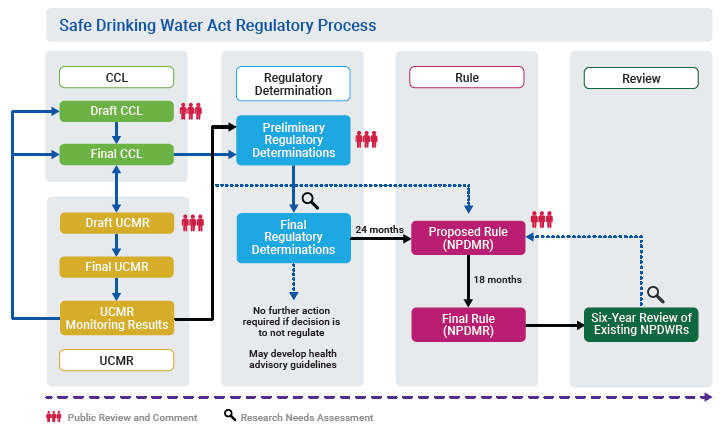
Figure 2. Safe Drinking Water Act Regulatory Process. Image Credit: PerkinElmer
1. UCMR 5 Program
The development of the UCMR 5 Timeline began in 2018-2020 and involved numerous stakeholder meetings.
Post Proposal initiative implementation began in 2020, kicking off the lab approval program, SDWARS registration and inventory notifications for PWSs, partnership agreements, state monitoring plans, and PWS inventory. The UCMR 5 published its final rule last year on 12/27/21.4
EPA pre-sampling commenced in 2022, with the sampling period taking place from 2023 to 2025 and the postsampling activity taking place in 2026.
The UCMR 5 declares that sample collection from all public water systems that serve at least 3,300 people and 800 representative public water systems that serve fewer than 3,300 people would take place over a 12-month period between January 2023 and December 2025.
Future considerations involving the development of the UCMR include prioritizing extra PFAS for the UCMR 6, as techniques to measure PFAS advance and are validated.4
The following key definitions are crucial to understanding the UCMR 5 scope:
- Public Water System (PWS): Supplies water for human consumption via pipes or other constructed conveyances to a minimum of 15 service connections or serves an average of at least 25 people for at least 60 days a year.
- Community Water System (CWS): PWS that provides water to the same population year-round.
- Non-transient, Non-community Water Systems (NTNCWS): PWS that provides water to at least 25 of the same people for at least six months of the year/not year-round.
- Transient, Non-Community System Water System (TNCWS): PWS that provides water where people do not remain for long periods.
2. Key Changes from UCMR 4 to UCMR 5
The main changes that took place from UCMR 4 to UCMR 5 include:
- Removal of various requirements based on system size, with no monitoring tier list
- Expanded to apply to all CWS/NTNCWS serving at least 3,300 people
- 800 randomly selected PWSs serving fewer than 3,300 people
- AWIA of 2018: Funding increased PWS scope for EPA to cover sample shipping and analytical costs.4
3. UCMR Implementation Team and Sampling Design
The EPA has modified its role and has directives to support small and large PWSs.
For small PWSs, their role involves the maintenance of both UCMR laboratory approval and contracts to support UCMR, compiling contact and inventory information, executing sample kit distribution and tracking, reviewing SDWARS data and reporting this to NCOD, and utilization of SDWARS for outreach.4
The EPA is accountable for the following for the UCMR Laboratory Program for small PWSs:
- Engagement with PWSs and States for sample collection
- Funding expenses for sampling kits, sample shipping, and sample analyses
- Coordination with contract laboratories for sample analyses and payment for services
- Reviewing results and QC data
- Reporting results to PWSs and States via SDWARS
For large PWSs, their role involves reviewing SDWARS data for completeness, reporting to NCOD, supporting users of the SDWARS system, updating PWS inventory and schedules as needed, providing technical assistance, and utilizing SDWARS for outreach.4
Large PWSs are responsible for the following for the UCMR Laboratory Program:
- The cost of sample analyses
- Coordination of sample shipping and analyses with EPA-approved UCMR 5 laboratories
- Laboratories post data to SDWARS
- Reviewing and approval of data in SDWARS
States have access to results following the large PWS review period.
UCMR execution is allocated across three entities: EPA Regional Offices, EPA Office of Ground and Drinking Water, and Partnering States. A breakdown of the responsibilities of each of these members is displayed in Figure 3.4
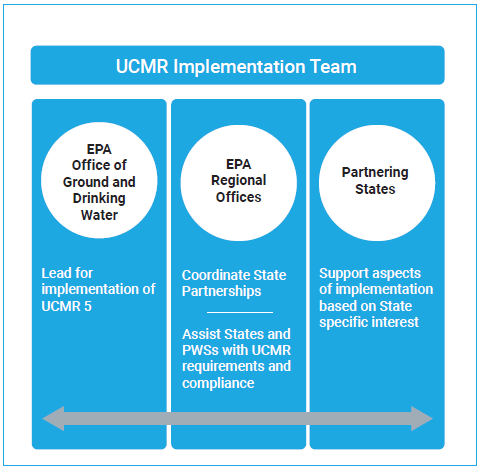
Figure 3. UCMR Implementation Team and Responsibilities. Image Credit: PerkinElmer
4. UCMR Sampling Design, Monitoring, and Reporting Design
The sampling design is evaluated by stakeholders and is subsequently peer-reviewed, with 800 randomly chosen small PWSs (serving less than 3300) informed by 02/22/22. The data quality aims were summarized as follows:
- At least two small systems chosen per state
- Occurrence data for unbiased national exposure estimates
- Population weighted
- Representative of both PWS size and source water type
Monitoring
The EPA is pursuing the addition of funding to cover all PWSs serving 3,300-10,000 people. However, only 8% is currently covered.
The present strategy for assessing the monitoring involves establishing the national contaminant occurrence, developing a primary tier and scope, utilizing available methods and frequently-used techniques, and ensuring consistency with AWIA provisions.5
Reporting
The Minimum Reporting Limit (MRL) is the minimum quantitation level that can be attained (with 95% confidence) by analysts in at least 75% of US laboratories employing a specific method.
The EPA establishes MRL using data from multiple labs performing “Lowest Concentration Minimum Reporting Level (LCMRL) studies to identify capability.
Each laboratory’s LCMRL is the lowest true concentration for which future recovery is projected to decrease to between 50%-150% recovery, with high confidence at 99%.
Thus, the LCMRL is the lowest concentration that specified quality measurements can be made by a lab. The MRL functions to produce quality and consistency across UCMR labs while balancing lab capacity.6
5. UCMR Process for Laboratory Participation and Cost
The process for laboratory participation in UCMR lasts approximately three to six months and is comprised of six steps. Figure 4 displays an overview of the UCMR lab participation process.7
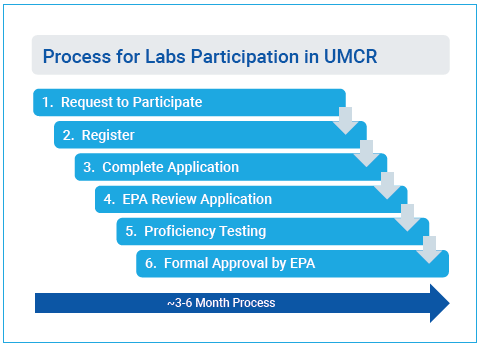
Figure 4. UCMR lab participation process overview. Image Credit: PerkinElmer
Key changes made from UCMR 4 to UCMR 5 for a lab’s participation include:
- UCMR 4 stated that for participation as a UCMR laboratory, registration was required within 60 days of final rule publication (12/20/16) and application within 120 days. UCMR 5 stated that for participation as a UCMR lab, registration and application were required to be completed by 08/01/22. These amendments were implemented to allow increased flexibility for interested labs.
- Regarding proficiency testing (PT), EPA planned to offer three PT studies before 12/27/21 (final rule publication) and three PT studies after this.
A total of 18 laboratories had been approved for UCMR 5 as of January 2022, with further PT studies expected to be added. Based on the existing funding, the total number of small PWSs participating is approximately 1,200, with a high demand for more approved labs.7
Table 1 presents the approximate cost for UCMR 5 Sample Sets and the estimated cost of the proposed UCMR 5 over the five-year cycle.
Table 1. The approximate cost for UCMR 5 Sample Sets and the estimated cost of the proposed UCMR 5 over the five-year cycle. Source: PerkinElmer
| Approximate Cost for UCMR 5 Sample Sets |
| Method Type |
Average Analysis Cost per UCMR 5 Sample1 |
| 25 PFAS using EPA Method 533 (SPE - LC/MS/MS) |
$376 |
| 4 PFAS using EPA Method 537.1 (SPE - LC/MS/MS) |
$302 |
| 1 Metal using EPA Method 200.7 (ICP-OES/AES) or M2 or ASTM3 |
$62 |
| Estimated Total2 for 1 UCMR 5 Sample Set |
$740 |
1 The average analytical cost was determined by averaging estimates provided by four drinking water laboratories
2 Standard Method (SM) 3120 B or SM 3120 B-99
3 ASTM International (ASTM) D1976-19
| Approximate Cost for UCMR 5 Program |
| Est. Average Annual Cost of the Proposed UCMR 5 Over the Five-year Cycle1 |
| PWSs Entity |
Average Annual Cost (Million) (2022-2026)2 |
| Small Systems (<10,000), including labor3 only (non-labor costs4 paid by EPA) |
$0.3 |
| Large Systems (10,001 – 100,000), including labor and non-labor costs |
$7.2 |
| Very Large Systems (>100,000), including labor and non-labor costs |
$2.3 |
| States, including labor costs related to implementation coordination |
$0.8 |
| EPA, including labor for implementation and nonlabor for small PWSs testing |
$10.5 |
| Average Annual National TOTAL for 1 UCMR 5 2023-2026 |
$21.1 |
1 Based on the scope of small-system monitoring described in AWIA
2 Totals may not equal the sum of components due to rounding
3 Labor costs pertain to systems, States, and EPA. Costs include activities such as reading the rule, notifying systems to participate, sample collection, data review, reporting, and record keeping
4 Non-labor costs will be incurred primarily by EPA and by large and very large PWSs. They include the costs of shipping samples to labs for testing and the cost of analysis
6. PWS’s Sampling Program
The Ground Water Representative Monitoring Plan Program (GWRMP) is an option for PWSs with groundwater sources to help decrease the amount of monitoring required.
The main UCMR 5 PWS proposal requirements are as follows:
- Site map showing all well locations in addition to all proposed representative wells.
- Uniform Contamination susceptibility among both the represented wells and representative well.
- Historical groundwater quality data demonstrating similarity between represented/representative well(s). Either all wells have the same treatment or no treatment.
Applications by PWSs must be submitted six months before the scheduled collection. PWSs with multiple EPTDSs may suggest sampling at representative locations instead of sampling at each EPTDS.
PWSs may reuse previously used UCMR GWRMPs if no significant changes in EPTDSs configurations have occurred. If revisions to the former plan must be carried out, an amendment request is required. Table 2 presents the key dates for the GWRMP program for PWSs.8
Representative sampling from wholesaler connections is an option for PWSs that acquire water with multiple connections from the same wholesaler to minimize monitoring.8
7. UCMR 5 Sampling Requirements: Frequency and Location
PWSs will follow the traditional UCMR sampling protocol, where sample collection occurs at entry points to the distribution system (EPTDS) for all UCMR 5 contaminants. Table 2 displays an outline of this.
Table 2. UCMR 5 Sampling Requirements for Frequency and Location. Source: PerkinElmer
| UCMR 5 Sampling Requirements - Frequency and Location |
| Water Source |
Timeframe |
Frequency |
| Surface water, ground water under the direct influence of surface water, or mixed sources systems |
Year-round |
Systems must monitor 4 times during a consecutive 12-month monitoring period. Sample events must occur 3 months apart |
| Ground water systems |
Year-round |
Systems must monitor 2 times during a consecutive 12-month monitoring period. Sample events must occur 5-7 months apart |
- PWSs will follow traditional UCMR sampling protocol
- Samples to be collected at entry points to the distribution systems (EPTDS) for all UCMR 5 contaminants
8. SDWARS 5 and CDX: Reporting
Both UCMR 5 PWSs and Approved Labs utilize the Safe Drinking Water Accession and Reporting System (SDWARS 5) for the reporting of results. The Central Data Exchange, a secure, internet-based electronic reporting system, is utilized for uploading analytical reports.8
EPA is in the process of providing access to CDX and SDWARS user instructions, in addition to training sessions by key stakeholders, including PWSs, labs, and States.
PFAS Analytical Methods to Monitor Drinking Water
The SDWA requires the EPA to employ validated analytical methods for the assessment of newly detected or unidentified PFAS chemicals and to update analytical methods for monitoring further PFAS.
As the identification of new PFAS compounds of concern occurs, the EPA will obtain certified reference standards that are necessary for their quantitation in drinking water samples.
The EPA will also conduct an evaluation of the analytical methods previously published for monitoring PFAS in drinking water, including EPA Method 537.1 and Method 533, to establish the efficacy of expanding the established target PFAS analyte list for inclusion of any emerging PFAS to support future drinking water monitoring programs.2
Robust techniques for detecting and quantifying PFAS are crucial and support the evaluation of the efficacy of various technologies for remediation. UCMR 5 insists on the analysis of 29 PFAS compounds via validated EPA methods 533 and 537.1.
Table 3 details a list of targeted PFAS in drinking water.
Table 3. Targeted Contaminants and Methods. Source: PerkinElmer
| Organics – 29 PFAS Compounds |
| EPA Method 537.1 Solid Phase Extraction (SPE) Liquid Chromatography-Tandem Mass Spectrometry (LC-MS/MS) |
EPA Method 537.1 Solid Phase Extraction (SPE) Liquid Chromatography-Tandem Mass Spectrometry (LC-MS/MS) |
| PFBS0.003 |
PFDA0.003 |
NMeFOSAA0.006 |
NFDHA0.002 |
PFPeA0.003 |
| PFHxA0.003 |
PFNA0.004 |
NEtFOSAA0.005 |
PFBA0.005 |
PFPeS0.004 |
| PFHxS0.03 |
PFUnA0.002 |
11Cl-PF3OUdS0.005 |
PFEESA0.003 |
4:2 FTS0.003 |
| PFHpA0.03 |
PFDoA0.003 |
9Cl-PF3ONS0.002 |
PFHpS0.003 |
6:2 FTS0.005 |
| PFOA0.004 |
PFTA0.008 |
ADONA0.003 |
PFMPA0.004 |
8:2 FTS0.005 |
| PFOS0.004 |
PFTrDA0.007 |
HFPO-DA(GenX)0.005 |
PFMBA0.003 |
|
- Unique to EPA Method 537.1 EPA groups the analytes common to Method 537.1 and 533 under 533 as recommended workflow
- MRLs (min reporting limit) are in superscript in μg/L
| Metals |
EPA Method 200.7
Inductively Coupled Plasma-Atomic Emission Spectrometry (ICP-AES)
Alternate SM 3120 B or ASTM D1976-20 |
| Lithium9 |
Optimization of PFAS Analytical Method 533 and Method 537.1
The EPA’s priority to update their analytical methods for PFAS has encouraged companies like to PerkinElmer to validate and optimize the following methods:
- Method 537.1: A method specialized for the analysis of PFAS in drinking water
- Method 533: A more inclusive method intended for monitoring the multiple short-chain PFAS that are challenging to be measured using Method 537.1.
In PerkinElmer’s application notes for Method 533 and Method 537.1, experts not only validated the method but substantially enhanced the methodology utilizing the PerkinElmer QSight®LX50 ultra-high-performance liquid chromatography (UHPLC) system together with the PerkinElmer QSight 220 triple quadrupole mass spectrometer.
Mitigate PFAS Background Contamination
A significant challenge involved in the analysis of trace quantities of PFAS is contamination. This includes the contamination of blanks, SPE apparatus, volumetric ware, samples and QC samples (originating from the materials used in reagents), sample collection materials, the LC/MS system, vials, and the lab environment.
Customized solutions are essential for remediating an LC/MS/MS system of PFAS background contamination.9,10
These remediation steps include the following:
- A delay column being positioned between the sample valve in the autosampler and the mobile phase mixer in the pump to trap and delay any PFAS compounds developing from the pump and mobile phase solvents.9,10
- The standard LX50 autosampler contains PTFE tubing internally, as well as to the wash solution reservoirs that participate in PFAS contamination. This contamination can be remediated by replacement of all PTFE tubing in the autosampler with PEEK tubing. 9,10
Optimized Runtimes
PerkinElmer’s application notes also described optimizing the chromatographic methods detailed in EPA 533 and 537.1.9,10
- Optimization of EPA Method 537.1
PerkinElmer reduced the injectionto-injection run time from the original EPA chromatographic method, from 37 minutes to just 10 minutes for their developed method. Figure 5 displays the total ion chromatogram (TIC) for the PerkinElmer 537.1 application note.9
PerkinElmer reduced the injectionto-injection run time from the original EPA chromatographic method, from 35 minutes to just 10 minutes for their developed method. The total ion chromatogram (TIC) for the PerkinElmer 533 application note is presented in Figure 6.
Source: PerkinElmer
| Analyte |
Peak # |
RT (min) |
IS# Ref |
| PFBS |
1 |
3.54 |
2 |
| PFHxA |
2 |
4.15 |
1 |
| HFPO-DA |
4 |
4.34 |
1 |
| PFHpA |
6 |
4.78 |
1 |
| PFHxS |
7 |
4.77 |
2 |
| ADONA |
8 |
4.84 |
1 |
| PFOA |
9 |
5.30 |
1 |
| PFOS |
11 |
5.73 |
2 |
| PFNA |
13 |
5.74 |
1 |
| 9CI-PF3ONS |
14 |
5.93 |
2 |
| PFDA |
15 |
6.13 |
1 |
| NMeFOSAA |
17 |
6.31 |
3 |
| PFUnA |
19 |
6.45 |
1 |
| NEtFOSAA |
20 |
6.47 |
3 |
| 11 CI-PF3OUdS |
22 |
6.56 |
2 |
| PFDoA |
23 |
6.72 |
1 |
| PFTrDA |
24 |
6.96 |
1 |
| PDTA |
25 |
7.16 |
1 |
| 13C2-PFHxA SS#1 |
3 |
4.15 |
1 |
| 13C3-HFPO-DA SS#2 |
5 |
4.34 |
1 |
| 13C2-PFDA SS#3 |
16 |
6.12 |
1 |
| d5-NEtFOSAA SS#4 |
21 |
6.46 |
3 |
| 13C2-PFOA IS#1 |
10 |
5.29 |
- |
| 13C4-PFOS IS#2 |
12 |
5.74 |
- |
| d3- NMeFOSAA IS#3 |
18 |
6.30 |
- |
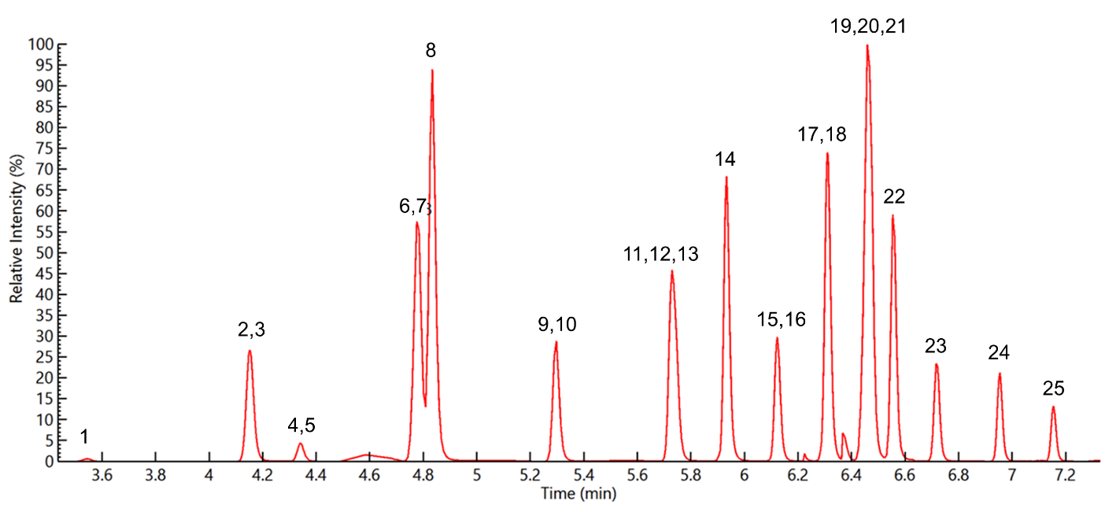
Figure 5. Total ion chromatogram of an 80 ng/L extracted LFB sample containing all method analytes, surrogates and internal standards. Image Credit: PerkinElmer
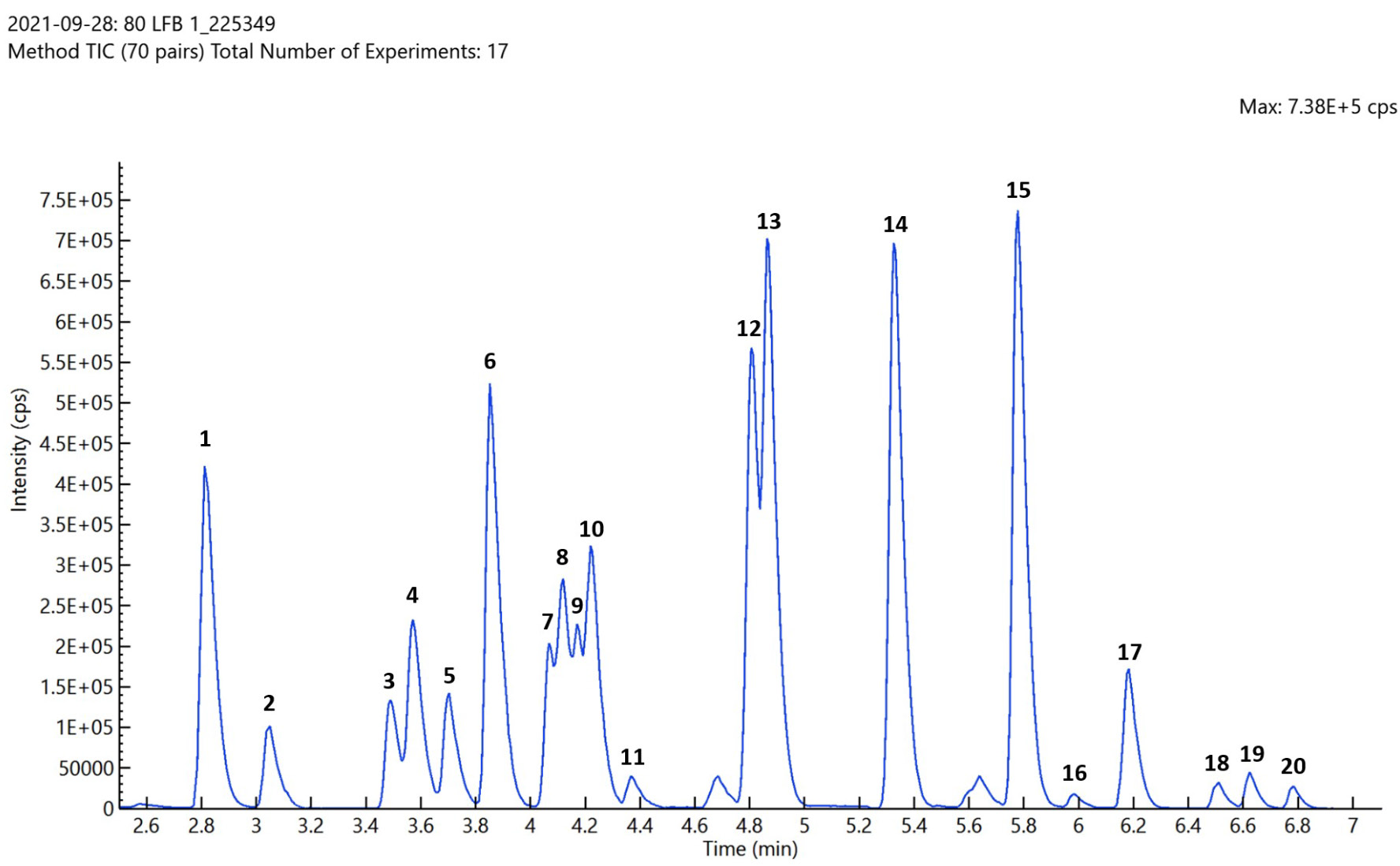
Figure 6. Total ion chromatogram of an 80 ng/L extracted LFB sample containing all method analytes and standards. Image Credit: PerkinElmer
PFAS Analytical Method 1633
A part of the Clean Water Act (CWA), Method 1633 was developed to determine solid (such as soil, sediment, and biosolids), aqueous, and tissue samples with the use of liquid chromatography/mass spectrometry (LC-MS/MS).
This method enables the quantification and calibration of PFAS analytes using isotopically labeled standards. Although this is not a required method in UCMR 5, it is a noteworthy method for PFAS analysis in non-potable matrices.
The Future of PFAS
There are more than 7000 PFAS-related compounds at present, with the production of many more derivative PFAS compounds expected to take place in future development. The vast scale of PFAS products necessitates careful analysis and review as more is learned.
Key highlights for the future outlook of PFAS include the following:
1. Final Toxicity Assessments for GenX and Additional PFAS
The EPA has stated that it will publish the toxicity assessments for two PFAS. These are hexafluoropropylene oxide dimer acid and its ammonium salt, also known as GenX chemicals.
GenX chemicals are deemed particularly prevalent in drinking water with known effects on human health, such as reproductive and immunological toxicities, as well as on the environment.
The aim of the toxicity assessment for GenX is to continue the development of a robust understanding of how these additional PFAS affect the environment and health.
In addition to the GenX PFAS, the Office of Research and Development is also developing toxicity assessments for five further PFAS, including PFHxA, PFBA, PFNA, PFHxS, and PFDA.2
2. Targeted and Non-Targeted Method Development
EPA is currently in the process of planning the development of further targeted methods for the detection and measurement of specific PFAS and non-targeted methods for the identification of unknown PFAS in the environment.2
3. Total PFAS Method Development
Additional method development will be utilized for total PFAS methods that measure the amount of PFAS in environmental samples without identifying specific PFAS.2 The total PFAS method development timeline is outlined as follows:
- Produce a total adsorbable fluorine method for wastewater for potential laboratory validation (Fall 2027).
- Develop a method for measurement of additional PFAS in air emissions (Fall 2022).
- Draft methods and approaches for the evaluation of PFAS leaching from solid materials (Fall 2022).
4. Identifying PFAS Categories
Part of the difficulty in collecting information on PFAS is due to them being such a large and diverse class of compounds. In response to the large number of PFAS presently in use, the EPA is planning on classifying the PFAS compounds into smaller categories.
These categories will be based on parameters such as physical and chemical properties, chemical structure, and toxicological properties.2
The EPA has defined two techniques for the categorization of PFAS:
- Utilization of toxicity and toxicokinetic data for the development of PFAS categories for additional hazard assessment and to inform risk or hazard-based decisions.
- Development of PFAS categories based on removal technologies using the present understanding of treatment, remediation, disposal, destruction, mitigation, and control principles.
These approaches will aid in the identification of missing elements in the EPA’s understanding of PFAS from removal technology and hazard assessment perspectives, helping the EPA to prioritize future actions.
The EPA is also going to develop a PFAS categorization database that will describe key characteristics of individual PFAS, such as category assignments.2
Conclusion
As advances in PFAS testing move towards the expansion of PFAS toxicity assessments, optimization methods, and identification of further PFAS categories, it will become increasingly important for researchers to develop improvements within method development for enhanced PFAS analysis.
Addressing the issues with PFAS analysis is vital for a complete understanding of PFAS toxicities and their environmental effects.
Accurately developed and validated methods, including those given by PerkinElmer, enable contamination mitigation, enhanced throughput, and decreased runtimes when it comes to resolving these issues.
The danger of PFAS contamination is a global concern. It is paramount that the combined endeavors of regulatory authorities, water treatment facilities, and analytical technology manufacturers continue to develop the needed advances and legislation to enable necessary PFAS research and mitigation.
References
- US EPA. “EPA's PFAS Action Plan: A Summary of Key Actions”. https://www.epa.gov/sites/default/files/2019-02/documents/pfas_action_factsheet_021319_final_508compliant.pdf.
- US EPA. “PFAS Strategic Roadmap: EPA’s Commitments to Action 2021—2024”. October 2021, https://www.epa.gov/system/files/documents/2021-10/pfas-roadmap_final-508.pdf.
- US EPA. “Safe Drinking Water Information”. 14 July 2015, https://www.epa.gov/ground-water-and-drinking-water/safe-drinking-water-information.
- US EPA. “Ground Water and Drinking Water”. 25 June 2019, www.epa.gov/ground-water-and-drinking-water.
- US EPA, OW. “Monitoring Unregulated Contaminants in Drinking Water”. www.epa.gov, 3 Aug. 2015, www.epa.gov/dwucmr.
- US EPA, OW. “Reporting Requirements for the Unregulated Contaminant Monitoring Rule UCMR 5”. www.epa.gov, 1 Sept. 2015, https://www.epa.gov/dwucmr/reporting-requirements-unregulated-contaminant-monitoring-rule-ucmr-5.
- US EPA. “Laboratory Approval Program for the Unregulated Contaminant Monitoring Rule (UCMR 5)”. www.epa.gov, 1 Sept. 2015, https://www.epa.gov/dwucmr/laboratory-approval-program-unregulated-contaminant-monitoring-rule-ucmr-5.
- US EPA. “The Fifth Unregulated Contaminant Monitoring Rule (UCMR 5) Program Overview Fact Sheet”. https://www.epa.gov/system/files/documents/2022-02/ucmr5-factsheet.pdf
- Weisenseel J., Costanzo M., “Analysis of Perfluoroalkyl and Polyfluoroalkyl Substances in Drinking Water: Validation Studies of EPA Method 537.1 Using the QSight 220 UHPLC/MS/MS”. https://www.chromatographyonline.com/view/analysis-of-perfluoroalkyl-and-polyfluoroalkyl-substances-in-drinking-water-validation-studies-of-epa-method-537-1-using-the-qsight-220-uhplc-ms-ms.
- Belunis A., LaCourse W., Costanzo M., Weisenseel J., “Improved Throughput for the Analysis of Perfluoroalkyl and Polyfluoroalkyl Substances in Drinking Water by EPA Method 533”.

This information has been sourced, reviewed and adapted from materials provided by PerkinElmer.
For more information on this source, please visit PerkinElmer.